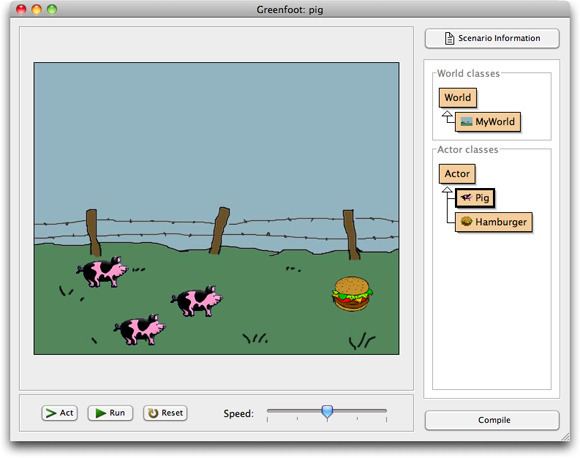Repository no%20value | Operating system Available in Multilingual | |
 | ||
Stable release 3.0.2 / 23 December 2015; 14 months ago (2015-12-23) | ||
Greenfoot is an interactive Java development environment designed primarily for educational purposes at the high school and undergraduate level. It allows easy development of two-dimensional graphical applications, such as simulations and interactive games.
Contents
Greenfoot is being developed and maintained at the University of Kent, with support from Oracle. It is free software, released under the GPL license. Greenfoot is available for Windows, OS X, Linux, Solaris, and any recent JVM.
History
The Greenfoot project was initiated by Michael Kölling in 2003, and a first prototype was built by Poul Henriksen (masters student) and Michael Kölling (supervisor) in 2003/2004. From 2005 development was continued involving the other members of the BlueJ Group at the University of Kent and Deakin University.
The first full release, Greenfoot version 1.0, was published on 31 May 2006, with further releases following occasionally thereafter.
In May 2007, the Greenfoot project was awarded the "Duke's Choice Award" in the category "Java Technology in Education", and in 2010 it won the "Premier Award for Excellence in Engineering Education Courseware".
In March 2009, Greenfoot project became free and open source software, and licensed under GNU GPL with Classpath exception.
In August 2009, a textbook was published that teaches programming with Greenfoot.
Use and programming model
The Greenfoot programming model consists of a World class (represented by a rectangular screen area) and any number of actor objects that are present in the world and can be programmed to act independently. The world and actors are represented by Java objects and defined by Java classes. Greenfoot offers methods to easily program these actors, including method for movement, rotation, changes of appearance, collision detection, etc.
Programming in Greenfoot at its most basic consists of subclassing two built-in classes, World and Actor. An instance of the world subclass represents the world in which Greenfoot execution will occur. Actor subclasses are objects that can exist and act in the world. An instance of the world subclass is automatically created by the environment.
Execution in Greenfoot consists of a built-in main loop that repeatedly invokes each actor's act method. Programming a scenario, therefore, consists mainly of implementing act methods for the scenario's actors. Implementation is done in standard Java. Greenfoot offers API methods for a range of common tasks, such as animation, sound, randomisation, and image manipulation. All standard Java libraries can be used as well, and sophisticated functionality can be achieved.
Pedagogy
Greenfoot aims to motivate learners quickly by providing easy access to animated graphics, sound and interaction. The environment is highly interactive and encourages exploration and experimentation. Pedagogically, the design is based on constructivist and apprenticeship approaches.
Secondly, the environment is designed to illustrate and emphasize important abstractions and concepts of object-oriented programming. Concepts such as the class/object relationship, methods, parameters, and object interaction are conveyed through visualizations and guided interactions. The goal is to build and support a mental model that correctly represents modern object-oriented programming systems.
Learner community
For users of Greenfoot, a community site called the Greenfoot Gallery provides a platform to publish and discuss their projects. Anyone can set up an account on the Greenfoot Gallery and publish their work. When published, scenarios run live in a web browser, and are instantly playable by anyone worldwide. The ability to easily publish programming projects to the internet is seen as a significant motivator for young learners.
Educator community
For educators, the project provides the Greenroom, a community site to discuss teaching strategies, exchange experiences and share material. In addition to a discussion forum, the Greenroom provides a shared repository of teaching resources, including numerous worksheets, project ideas, slide sets and other teaching aids.
Releases
In version 2.0, the editor and API received some major changes from the previous version 1.5.6. The editor added support for code completion, coloured scope highlighting, improved find and replace, and a new navigation view. A built-in sound recorder was added, as well as better support for sound in scenarios through a new high level sound class called GreenfootSound . It adds the ability to pause and loop sounds, as well as adding MP3 support.
